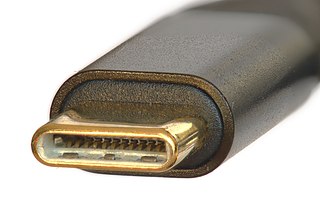Related Research Articles

Universal Serial Bus (USB) is an industry standard that specifies the physical interfaces and protocols for connecting, data transferring and powering of hosts, such as personal computers, peripherals, e.g. keyboards and mobile devices, and intermediate hubs. USB was designed to standardize the connection of peripherals to computers, replacing various interfaces such as serial ports, parallel ports, game ports, and ADB ports. It has become commonplace on a wide range of devices, such as keyboards, mice, cameras, printers, scanners, flash drives, smartphones, game consoles, and power banks.

Digital Visual Interface (DVI) is a video display interface developed by the Digital Display Working Group (DDWG). The digital interface is used to connect a video source, such as a video display controller, to a display device, such as a computer monitor. It was developed with the intention of creating an industry standard for the transfer of uncompressed digital video content.

VESA, formally known as Video Electronics Standards Association, is an American technical standards organization for computer display standards. The organization was incorporated in California in July 1989 and has its office in San Jose. It claims a membership of over 300 companies.

A graphics card is a computer expansion card that generates a feed of graphics output to a display device such as a monitor. Graphics cards are sometimes called discrete or dedicated graphics cards to emphasize their distinction to integrated graphics processor on the motherboard or the CPU. A graphics processing unit (GPU) that performs the necessary computations is the main component in a graphics card, but the acronym "GPU" is sometimes also used to refer to the graphics card as a whole.

High-Definition Multimedia Interface (HDMI) is a proprietary audio/video interface for transmitting uncompressed video data and compressed or uncompressed digital audio data from an HDMI-compliant source device, such as a display controller, to a compatible computer monitor, video projector, digital television, or digital audio device. HDMI is a digital replacement for analog video standards.
In computing, a docking station or port replicator (hub) or dock provides a simplified way to plug-in a mobile device, such as a laptop, to common peripherals. Because a wide range of dockable devices—from mobile phones to wireless mouse—have different connectors, power signaling, and uses, docks are unstandardized and are therefore often designed for a specific type of device.

DisplayPort (DP) is a digital display interface developed by a consortium of PC and chip manufacturers and standardized by the Video Electronics Standards Association (VESA). It is primarily used to connect a video source to a display device such as a computer monitor. It can also carry audio, USB, and other forms of data.

PDMI is an interconnection standard for portable media players. It has been developed by CEA as ANSI/CEA-2017-A standard Common Interconnection for Portable Media Players in February 2010. Chaired by David McLauchlan from Microsoft, the standard was developed with the input or support of over fifty consumer electronics companies worldwide.
Mobile High-Definition Link (MHL) is an industry standard for a mobile audio/video interface that allows the connection of smartphones, tablets, and other portable consumer electronics devices to high-definition televisions (HDTVs), audio receivers, and projectors. The standard was designed to share existing mobile device connectors, such as Micro-USB, and avoid the need to add additional video connectors on devices with limited space for them.

The Mini DisplayPort is a miniaturized and less common version of the DisplayPort audio-visual digital interface.

A dock connector is a connector used to attach a mobile electronic device simultaneously to multiple external resources. The dock connector will typically carry a variety of signals and power, through a single connector, to simplify the process of docking the mobile device. A dock connector may be embedded in a mechanical fixture used to support or align the mobile device or may be at the end of a cable.
Audio connectors and video connectors are electrical or optical connectors for carrying audio or video signals. Audio interfaces or video interfaces define physical parameters and interpretation of signals. For digital audio and digital video, this can be thought of as defining the physical layer, data link layer, and most or all of the application layer. For analog audio and analog video these functions are all represented in a single signal specification like NTSC or the direct speaker-driving signal of analog audio.

The Wireless Gigabit Alliance was a trade association that developed and promoted the adoption of multi-gigabit per second speed wireless communications technology "WiGig" operating over the unlicensed 60 GHz frequency band. The alliance was subsumed by the Wi-Fi Alliance in March 2013.
Thunderbolt is the brand name of a hardware interface for the connection of external peripherals to a computer. It has been developed by Intel, in collaboration with Apple. It was initially marketed under the name Light Peak, and first sold as part of an end-user product on 24 February 2011.

The FastPort was a proprietary polyconnection interface used on all Sony Ericsson cellphones between 2005 and 2010. Designed in response to Nokia's proprietary Pop-Port, FastPort provided data transfer, charging, headset and speaker connections through a common interface. It was discontinued in 2010 and replaced with a micro-USB for charging and data, and a TRRS connection for audio (headphones).

IEEE 1394 is an interface standard for a serial bus for high-speed communications and isochronous real-time data transfer. It was developed in the late 1980s and early 1990s by Apple in cooperation with a number of companies, primarily Sony and Panasonic. It is most commonly known by the name FireWire (Apple), though other brand names exist such as i.LINK (Sony), and Lynx.

USB-C is a 24-pin USB connector system with a rotationally symmetrical connector. The designation C refers only to the connector's physical configuration or form factor and should not be confused with the connector's specific capabilities, which are designated by its transfer specifications. The USB-C connector has rotational symmetry: a plug may be inserted into a receptacle in either orientation.

FreeSync is an adaptive synchronization technology for LCD and OLED displays that support a variable refresh rate aimed at avoiding tearing and reducing stuttering caused by misalignment between the screen's refresh rate and the content's frame rate.
The initial versions of the USB standard specified connectors that were easy to use and that would have acceptable life spans; revisions of the standard added smaller connectors useful for compact portable devices. Higher-speed development of the USB standard gave rise to another family of connectors to permit additional data paths. All versions of USB specify cable properties; version 3.x cables include additional data paths. The USB standard included power supply to peripheral devices; modern versions of the standard extend the power delivery limits for battery charging and devices requiring up to 100 watts. USB has been selected as the standard charging format for many mobile phones, reducing the proliferation of proprietary chargers.

USB4, sometimes referred to as USB 4.0, is a technical specification that the USB Implementers Forum (USB-IF) released on 29 August 2019. USB4 is based on the Thunderbolt 3 protocol specification, which Intel has donated to the USB-IF, but is aligned with the Thunderbolt 4 specification. The USB4 architecture can share a single, high-speed link with multiple hardware endpoints dynamically, best serving each transfer by data type and application.
References
- ↑ Ryan, Thomas (September 4, 2012). "The Magic of AMD's Lightning Bolt". SemiAccurate . Retrieved January 7, 2014.
- ↑ "DisplayPort™ Adds DockPort Extension to Royalty-Free VESA Standard" (Press release). VESA. January 7, 2014. Retrieved January 7, 2014.
- ↑ "displayport announces dockport". VESA. June 3, 2014.
- ↑ Smith, Ryan (January 7, 2014). "AMD/TI's DockPort Adopted As Official Extension to DisplayPort Standard". AnandTech . Retrieved January 7, 2014.